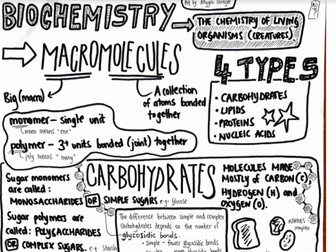
Macromolecules Summarised (3/4)
**Personally hand-illustrated colouring summary sheet perfect for any age of student (trust me!) summarising the basic concepts of:
Carbohydrates**
Lipids
Proteins
This charming single-page summary sheet is perfect to slip into any student handout. Excellent as a reference page for students to recall the basic components of the aforementioned macromolecules.
NOTE: Nucleic acids were excluded because they fall more neatly under Genetics, rather than Biochemistry.
Sans-serif handwriting and black-and-white arrangement make this easily adaptable for visibility/dyslexia support. Be sure to print on coloured paper to support your students!
Like what you see? Or not? REQUESTS TAKEN. Contact me privately for a quote.

